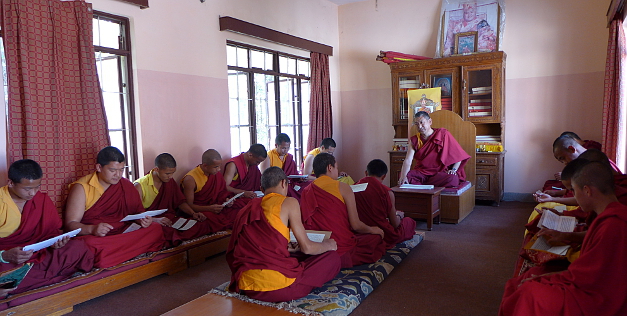Buddhist Philosophy Class (Shedra)
Having passed through the elementary schooling at the monastery the monk students enter the scriptural study program at the Gongkar Choede Shedra.The Shedra follows a curriculum based on the so-called Eighteen Great Treatises (Dragchen Chogye) that were formerly studied in the important Sakyapa scriptural seminaries of Tibet. The main content of these Indian treatises along with their Tibetan commentaries include Prajnaparamita, Vinaya, Madhyamaka, Abhidharma, Pramana. The commentarial treatises of the Sakya tradition include, for example Sakya Pandita’s Distinguishing the Three Vows and The Treasury of Reasoning On Valid Cognition; and the collected writings of Sakya scholastics like Gorampa Sonam Senge and Panchen Shakya Chokden. The six traditional categories are of these eighteen scriptures are:
The Perfection of Wisdom (Prajnaparamita; including the five treatises of Maitreya)
1. Abhisamayalamkara
2. Mahayanasutralamkara
3. Dharmadharmtavibhanga
4. Madhyantavibhanga
5. Anuttaratantrasastra
6. Bodhisattvacaryavatara of Santideva
Monastic Discipline (Vinaya)
7. Pratimoksasutra
8. Vinayasutra of Gunaprabha
Middle-Way Philosophy (Madhyamaka)
9. Mulamadhyamakakarika of Nagarjuna
10. Madhyamakavatara of Candrakiriti
11. Catuhsataka of Aryadeva
Phenomenology (Abhidarma)
12. Abhidharmakosa of Vasubandhu
13. Abhidharmasamuccaya of Asanga
Valid cognition and logic (Pramana)
14. Pramanasamuccaya of Dignaga
15. Pramanavartika of Dharmakirti
16. Pramanaviniscaya of Dharmakirti
17. The Treasury of Reasoning (Tsema Rigter) of Sakya Pandita
Right Practice of the Vows (Domsum)
18. Distinguishing the Three Vows (Domsum Rabye) of Sakya Pandita
